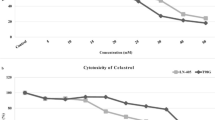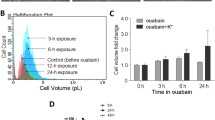Abstract
Objectives
In order to evaluate the improvement of the photodynamic therapy (PDT) due to sodium butyrate (NaBu), its effectiveness in U373-MG and D54-MG astrocytoma cell lines was evaluated.
Methods
Cells were exposed to delta-aminolevulinic acid (δ-ALA) as a precursor to endogenous photosensitizer protoporphyrin IX (PpIX). In both astrocytoma cells, an important increase by ALA was observed in uroporphyrinogen synthetase gene expression: 1.8- and 52-fold for D54-MG and U373-MG cells, respectively. After irradiation, they showed 16.67 and 28.9 % of mortality in U373-MG and D54-MG, respectively. These mortalities increased to 70.62 and 96.7 % when U373-MG and D54-MG cells, respectively, were exposed 24 h to 8 mM NaBu, before to PpIX induction. NaBu induced expression of caspase-3, caspase-9, and Bcl-2 and increased Bax in U373-MG cells. ALA-induced morphological changes are compatible to differentiation.
Conclusions
Genes and differentiation induced mainly by NaBu improve cell death performed by PDT in astrocytoma cells. These facts prove the synergistic effect of NaBu on cytotoxic damage induced by PDT.



Similar content being viewed by others
References
Chico-Ponce de León F, Castro-Sierra E, Pérezpeña-Diazconti M, Gordillo-Domínguez LF, Santana-Montero BL, Rocha-Rivero LE, Vaca-Ruíz MA, Ríos-Alanís M, Sánchez-Herrera F, Valdéz-Orduño R (2006) Tumores intracraneanos del niño. Bol Med Hosp Infant Mex 63:367–381
Kleihues P, Ohgaki H (1999) Primary and secondary glioblastomas: from concept to clinical diagnosis. Neurooncology 1:44–51
Schmidt-Erfurth U, Diddens H, Birngruber R, Hasan T (1997) Photodynamic targeting of human retinoblastoma cells using covalent low-density lipoprotein conjugates. Br J Cancer 75:54–61
Kessel D, Woodburn K (1993) Biodistribution of photosensitizing agents. Int J Biochem 25:1377–1383
Oleinick NL, Morris RL, Belichenko I (2002) The role of apoptosis in response to photodynamic therapy: what, where, why and how. Photochem Photobiol Sci 1:1–21
Wu SM, Ren QG, Zhou MO, Peng Q, Chen JY (2003) Protopporphyrin IX production and its photodynamic effects on glioma cells, neuroblastoma cells and normal cerebellar granule cells in vitro with 5-aminolevulinic acid and its hexylester. Cancer Let 200:123–131
Ruiz-Galindo E, Arenas-Huertero F, Ramón-Gallegos E (2007) Expression of genes involved in heme biosynthesis in the human retinoblastoma cell lines WERI-Rb-1 and Y79: implications for photodynamic therapy. J Exp Clin Cancer Res 26:195–200
Olivo M, Wilson BC (2004) Mapping ALA-induced PPIX fluorescence in normal brain and brain tumour using confocal fluorescence microscopy. Int J Oncol 25:37–45
Dailey HA, Smith A (1984) Differential interaction of porphyrins used in photoradiation therapy with ferrochelatase. Biochem J 223:441–445
Wild PJ, Krieg RC, Seidl J et al (2005) RNA expression profiling of normal and tumor cells following photodynamic therapy with 5-aminolevulinic acid-induced protoporphyrin IX in vitro. Mol Cancer Ther 4:516–528
Urnov FD (2003) Chromatin remodeling as a guide to transcriptional regulatory networks in mammals. J Cell Biochem 88:684–694
Gore SD, Carducci MA (2000) Modifying histones to care cancer: clinical development of sodium phenylbutyrate and other histone deacetylase inhibitors. Expert Opin Invest Drugs 9:2923–2934
Marks PA, Richon VM, Rifkind RA (2000) Histone deacetylase inhibitors: inducers of differentiation or apoptosis of transformed cells. J Natl Cancer Inst 92:1210–1216
Widmer J, Fassihi KS, Schlichter SC, Wheeler KS, Crute BE, King N, Nutile-McMenemy N, Noll WW, Daniel S, Ha J, Kim KH, Witters LA (1996) Identification of a second human acetyl-CoA carboxylase gene. Biochem J 316:915–922
Wang J, Saunthararajah Y, Redner RL, Liu JM (1999) Inhibitors of histone deacetylase relieve ETO-mediated repression and induce differentiation of AML1-ETO leukemia cells. Cancer Res 59:2766–2769
Butler LM, Agus DB, Scher HI, Higgins B, Rose A, Cordon-Cardo C, Thaler HT, Rifkind RA, Marks PA, Richon VM (2000) Suberoylanilide hydroxamic acid, an inhibitor of histone deacetylase, suppresses the growth of prostate cancer cells in vitro and in vivo. Cancer Res 60:5165–5170
Piomelli SA (1973) Micromethod for free erythrocyte porphyrins: the FEP test. J Lab Clin Med 81:932–940
Ramón-Gallegos E, DeLeón-Rodríguez I, Martínez-Guzmán LA, Pérez-Zapata AJ (1999) In vitro study of biosíntesis of protoporphyrin IX induced by δ-aminolevulinic acid in normal and cancerous cells of the human cervix. Arch Med Res 30:163–170
Kennedy JC, Pottier RH, Pross DC (1990) Photodynamic therapy with endogenous protoporphyrin IX: basic principles and present clinical experience. J Photochem Photobiol 6:143–148
Kemmner W, Wan K, Rüttinger S et al (2008) Silencing of human ferrochelatase causes abundant protoporphyrin-IX accumulation in colon cancer. FASEB J 22:500–509
Uzdensky A, Juzeniene A, Ma LW, Moan J (2004) Photodynamic inhibition of enzymatic detachment of human cancer cells from a substratum. Biochem Biophys Res Commun 322:452–457
Oltvai ZN, Milliman CL, Korsmeyer SJ (1993) Bcl-2 heterodimerizes in vivo with a conserved homolog, Bax, that accelerates programmed cell death. Cell 74:609–619
Neise D, Graupner V, Gillissen BF, Daniel PT, Schulze-Osthoff K, Janicke RU, Essmann F (2008) Activation of the mitochondrial death pathway is commonly mediated by a preferential engagement of Bak. Oncogene 27:1387–1396
Karmakar S, Banik NL, Patel SJ, Ray SK (2007) 5-Aminolevulinic acid-based photodynamic therapy suppressed survival factors and activated proteases for apoptosis in human glioblastoma U87MG cells. Neurosci Lett 415:242–247
Ortel B, Chen N, Brissette J, Dotto GP, Maytin E, Hasan T (1998) Differentiation-specific increase in ALA-induced protoporphyrin IX accumulation in primary mouse keratinocytes. Br J Cancer 77:1744–1751
Appelskog IB, Ammerpohl O, Svechnikova IG, Lui WO, Almqvist PM, Ekström TJ (2004) Histone deacetylase inhibitor 4-phenylbutyrate suppresses GAPDH mRNA expression in glioma cells. Int J Oncol 24:1419–1425
Flores-Ancona RM, Garcia-Gomez FY, Jimenez-Betanzos AM, Solis-Paredes M, Castro-Leyva V, Cruz-Orea A, Arenas-Huertero F, Ramon-Gallegos E (2009) Effects of sodium butyrate on cell death induced by photodynamic therapy in U373-MG and D54-MG astrocytoma cell lines. Photochem Photobiol 85:1182–1188
Li X-N, Shu Q, Su JM-F, Perlaky L, Blaney SM, Lau Ch C (2005) Valproic acid induces growth arrest, apoptosis, and senescence in medulloblastomas by increasing histone hyperacetylation and regulating expression of p21Cip1, CDK4, and CMYC. Mol Cancer Ther 4:1921–1922
Acknowledgments
Financing for this study was provided by Sistema de Investigación y Posgrado through project 20070480 under the direction of Eva Ramon-Gallegos. ERG is Sistema Nacional de Investigadores (SNI), Comisión Operadora para el Fomentos a las Actividades Académicas and Estímulo al Desarrollo de la Investigación fellow. F A-H is a member of the Sistema Nacional de Investigadores (SNI-I).
Author information
Authors and Affiliations
Corresponding author
Additional information
José Bueno-Carrazco, Violeta Castro-Leyva, Fanny García-Gomez, and Mario Solís-Paredes contributed equally in the paper.
Rights and permissions
About this article
Cite this article
Bueno-Carrazco, J., Castro-Leyva, V., García-Gomez, F. et al. Sodium butyrate increases the effect of the photodynamic therapy: a mechanism that involves modulation of gene expression and differentiation in astrocytoma cells. Childs Nerv Syst 28, 1723–1730 (2012). https://doi.org/10.1007/s00381-012-1828-3
Received:
Accepted:
Published:
Issue Date:
DOI: https://doi.org/10.1007/s00381-012-1828-3




